#7 Изучение работы методов контроля температуры в молекулярной динамике¶
Задание: https://kodomo.fbb.msu.ru/wiki/2016/8/MolSim/task7 Тут мы изучаем, как реализован контроль температуры в молекулярной динамике на примере GROMACS. Исследуем на молекуле этана.
Скачиваем GROMACS v4.5.5 с ftp://ftp.gromacs.org/pub/gromacs
cd ~
tar -xvf ~/Downloads/gromacs-4.5.5.tar.gz
cd gromacs-4.5.5
mkdir build
cd build
cmake ..
make
sudo make install
// не получилось :(, пробуем на codomofrom subprocess import run
Для работы нужно скачать с кодомо gro файл (http://kodomo.fbb.msu.ru/FBB/year_08/term6/etane.gro) с координатами этана и 5 конфигурационных файлов с разными алгоритмами контроля температуры.
%%bash
wget http://kodomo.fbb.msu.ru/FBB/year_08/term6/etane.gro
wget http://kodomo.fbb.msu.ru/FBB/year_08/term6/be.mdp
wget http://kodomo.fbb.msu.ru/FBB/year_08/term6/vr.mdp
wget http://kodomo.fbb.msu.ru/FBB/year_08/term6/nh.mdp
wget http://kodomo.fbb.msu.ru/FBB/year_08/term6/an.mdp
wget http://kodomo.fbb.msu.ru/FBB/year_08/term6/sd.mdp
Файл с топологией для этана нам дан, но его нужно подредактировать:
- дописать все необходимые связи, валентные и торсионные углы
- поменять типы атомов: CX на opls_135, а HX на opls_140
- задать тип потенциала торсионных углов равеным 3
et_file = open('etane.top', 'w')
head = '''
#include "/usr/share/gromacs/top/oplsaa.ff/forcefield.itp"
[ moleculetype ]
; Name nrexcl
et 3
[ atoms ]
; nr type resnr residue atom cgnr charge mass
1 opls_135 1 ETH C1 1 -0.189 12.01
2 opls_135 1 ETH C2 2 -0.155 12.01
3 opls_140 1 ETH H1 3 0.059 1.008
4 opls_140 1 ETH H2 4 0.059 1.008
5 opls_140 1 ETH H3 5 0.059 1.008
6 opls_140 1 ETH H4 6 0.056 1.008
7 opls_140 1 ETH H5 7 0.056 1.008
8 opls_140 1 ETH H6 8 0.056 1.008
[ bonds ]
; ai aj funct b0 kb
1 2 1
1 3 1
1 4 1
1 5 1
2 6 1
2 7 1
2 8 1
[ angles ]
; ai aj ak funct phi0 kphi
;around c1
3 1 4 1
3 1 5 1
4 1 5 1
2 1 3 1
2 1 4 1
2 1 5 1
;around c2
6 2 7 1
6 2 8 1
7 2 8 1
1 2 6 1
1 2 7 1
1 2 8 1
[ dihedrals ]
; ai aj ak al funct
3 1 2 6 3
3 1 2 7 3
3 1 2 8 3
4 1 2 6 3
4 1 2 7 3
4 1 2 8 3
5 1 2 6 3
5 1 2 7 3
5 1 2 8 3
[ pairs ]
; atom list for 1-4
; ai aj funct
3 6
3 7
3 8
4 6
4 7
4 8
5 6
5 7
5 8
[ System ]
; any text here
first one
[ molecules ]
;Name count
et 1
'''
et_file.write(head)
%%bash
cat etane.top
%%bash
#файл для подсчёта длины C-C связи
echo -e "[ b ]\n1 2" > b.ndx
cat b.ndx
Алгоритмы контроля температуры¶
thermo_types = ['be', 'vr', 'nh', 'an', 'sd']
for thermo in thermo_types:
# configs
run_arg = f'grompp -f {thermo}.mdp -c etane.gro -p etane.top -o etane_{thermo}.tpr'
print(run_arg)
run(run_arg, shell=True)
print(thermo + '\tconfig')
# mdrun
run_arg = f'mdrun -deffnm etane_{thermo} -v -nt 1'
print(run_arg)
run(run_arg, shell=True)
print(thermo + '\tmdrun')
# pdb
run_arg = f'echo 0 | trjconv -f etane_{thermo}.trr -s etane_{thermo}.tpr -o etane_{thermo}.pdb'
print(run_arg)
run(run_arg, shell=True)
print(thermo + '\tpdb')
# energies
run_arg = f'echo 10 11 | g_energy -f etane_{thermo}.edr -o etane_{thermo}_en.xvg -xvg none'
print(run_arg)
run(run_arg, shell=True)
print(thermo + '\tenergies')
# C-C bond lengths
run_arg = f'g_bond -f etane_{thermo}.trr -s etane_{thermo}.tpr -o bond_{thermo}.xvg -n b.ndx -xvg none'
print(run_arg)
run(run_arg, shell=True)
print(thermo + '\tbond lengths')
Отлично, спасибо kodomo. Теперь го локально.
import imageio
from IPython.display import display, Image
from pathlib import Path
import time
import os
import shutil
import asyncio
import numpy as np
from xmlrpc.client import ServerProxy
from IPython.core.display import HTML
IMAGE_FOLDER = 'pr7_assets'
Path(IMAGE_FOLDER).mkdir(parents=True, exist_ok=True)
cmd = ServerProxy(uri="http://localhost:9123/RPC2")
for thermo in thermo_types:
cmd.reinitialize()
cmd.set('sphere_scale', 0.2)
cmd.set('stick_radius', 0.1)
cmd.set('ray_trace_mode', 3)
cmd.set('antialias', 2)
cmd.set('sphere_scale', 0.2)
cmd.set('stick_radius', 0.1)
cmd.load(f'etane_{thermo}.pdb')
cmd.show('spheres')
cmd.orient()
print(thermo)
Path(thermo).mkdir(parents=True, exist_ok=True)
cmd.do('color deuterium, name H*')
cmd.do('color ruthenium, name C*')
cmd.do(f'mpng {thermo}/{thermo}, width=480, height=360, mode=2')
for thermo in thermo_types:
with imageio.get_writer(f'{thermo}.gif', mode='I', fps=30) as writer:
for i in range(0, 251):
image = imageio.imread(os.path.join(
f'{thermo}/', f'{thermo}{i + 1:04}.png'))
writer.append_data(image)
| метод Берендсена | метод "Velocity rescale" |
|---|---|
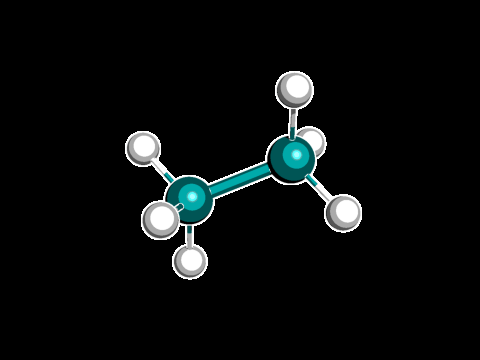 |
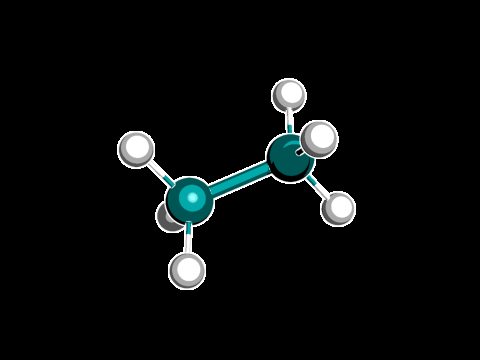 |
| метод Нуза-Хувера | метод Андерсена |
|---|---|
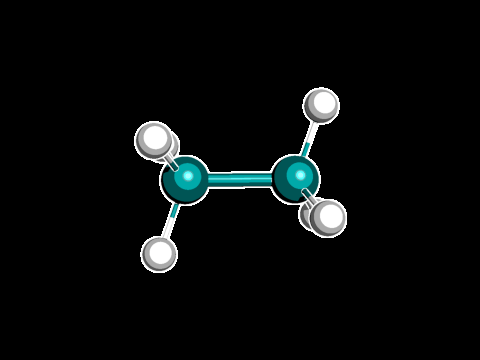 |
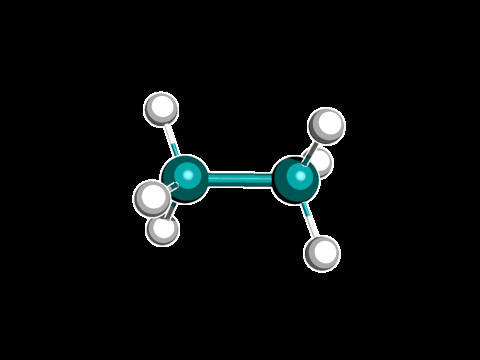 |
| метод стохастической молекулярной динамики |
|---|
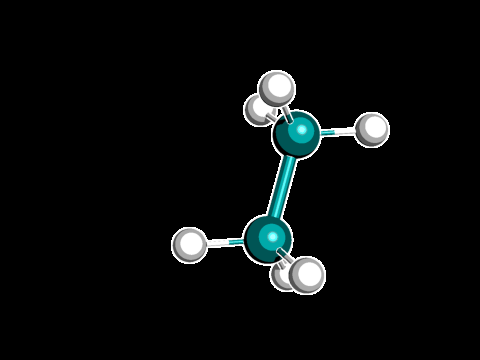 |
Так, получились чудесные гифки. Немного о сравнении алгоритмов:
- Метод Берендсена - вращение водородов вокруг С-С связи происходит почти равномерно. Это не очень правильно, так как мы знаем, что в заторможенной конформации этан существует больше времени, чем заслоненной, тк она более энергетически выгодна;
- Метод "Velocity rescale" - здесь уже можно увидеть, что есть две конформации, и в одной молекула адерживается. Кроме того, молекула перемещается в пространстве.
- Метод Нуза-Хувера - тоже видны две конформации, но молекула висит на одном месте. Кажется, есть небольшое колебание длины С-С связи.
- Метод Андерсена - молекула просто дрожит. Выглядит не очень правдоподобно.
- Метод стохастической молекулярной динамики - молекула двигается в пространстве хаотично, уловить движение вокруг связи не получается.
Видимо, самые удачные - это метод "Velocity rescale" и метод Нуза-Хувера, в зависимости от целей (хотим мы видеть вращение всей молекулы или нет) мтоит использовать один из них.
Анализ энергий¶
import numpy as np
import matplotlib.pyplot as plt
import matplotlib as mpl
thermo_names = ['Berendsen', 'V-rescale', 'Nose-Hoover', 'Andersen', 'Stochastic']
plt.figure(figsize=(15, 10))
for i, therms in enumerate(zip(thermo_types, thermo_names)):
mpl.style.use('seaborn')
thermo, name = therms
plt.subplot(2, 3, i + 1)
time, pot, kin = np.loadtxt(f'etane_{thermo}_en.xvg').T
plt.plot(time, kin + pot, label='total')
plt.plot(time, pot, alpha=.7, label='potential')
plt.plot(time, kin, alpha=.7, label='kinetic')
plt.xlabel('Time, ps')
plt.ylabel('Energy, kJ/mol')
plt.title(name)
plt.legend(title='Energies', loc='lower right')
plt.tight_layout()
- Методы Андерсена и Берендсена поддерживают полную энергию на постоянном уровне, потенциальная больше кинетической, колебания периодические. Энергия у Берендсена выше, чем у Андерсена. Остальные методы показывают большие колебания энергий.
- Метод Ноуз-Хувера показывает примерно одинаковые кинетическую и потенциальную энергии, но он часто оказывается около нуля, что не очень стабильно.
- V-rescale и стохастический методы похожи по стабильности колебаний энергии, но у стохастического вклад кинетической энергии больше (потому он выдает настолько хаотические метания).
По колебаниям энергий я бы сказала, что самый надежный метод - V-rescale.
Распределение длины C-C связи¶
target = 0.1522
plt.figure(figsize=(15, 10))
for i, therms in enumerate(zip(thermo_types, thermo_names)):
thermo, name = therms
plt.subplot(2, 3, i + 1)
lengths, values = np.loadtxt(f'bond_{thermo}.xvg').T
plt.bar(lengths, values, width=0.0003, label='data')
plt.axvline(target, color='red', label='0.1522 nm')
plt.xlim(target - 0.02, target + 0.02)
plt.xlabel('Bond length, nm')
plt.title(name)
plt.legend()
plt.tight_layout()
Пик распределения длины С-С во всех методах находится на значении 0.1522 нм. Методы Андерсена и Берендсена показывают меньшую дисперсию распределения длины связи, что ожидаемо, так как в этих методах меньше колебаниями энергии. У стохастического метода самые тяжелые хвосты и довольно большая дисперсия.
Распределение энергий¶
plt.figure(figsize=(15, 10))
for i, therms in enumerate(zip(thermo_types, thermo_names)):
thermo, name = therms
plt.subplot(2, 3, i + 1)
time, pot, kin = np.loadtxt(f'etane_{thermo}_en.xvg').T
plt.hist(kin + pot, bins=100)
plt.xlabel('Energy, kJ/mol')
plt.title(name + ": total energy distribution")
plt.tight_layout()
Честно говоря, не знаю, как это интерпретировать. Метод Ноуза-Хувера выдает результат, похожий на распределение Больцмана. Метод Андерсена из всех имеет минимальную дисперсию, метод Бренстеда выдал распределение как-то очень далеко уехавшее от нуля.
Итого, самый хороший метод учета влияния температуры, похоже Ноуз-Хувер.